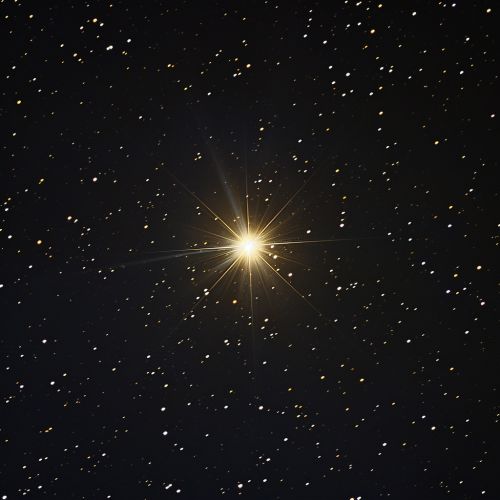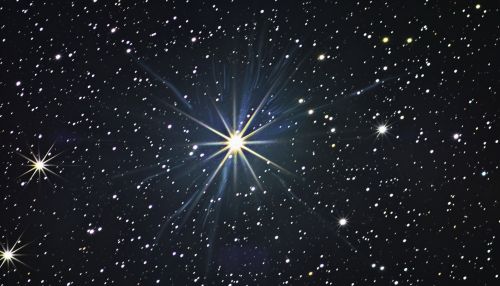Astronomical objects: Difference between revisions
(Created page with "== Introduction == Astronomical objects are physical entities, associations, or structures that exist in the observable universe. These objects range from the smallest particles to the largest structures known to humanity. The study of these objects, their properties, and their interactions is a fundamental aspect of astronomy and astrophysics. This article delves into the various types of astronomical objects, their characteristics, and t...") |
No edit summary |
||
| Line 9: | Line 9: | ||
Stars are luminous spheres of plasma held together by their own gravity. They are the primary building blocks of galaxies and play a crucial role in the universe's energy balance. Stars form from the gravitational collapse of gas and dust in molecular clouds. The core of a star undergoes nuclear fusion, converting hydrogen into helium and releasing energy in the form of light and heat. | Stars are luminous spheres of plasma held together by their own gravity. They are the primary building blocks of galaxies and play a crucial role in the universe's energy balance. Stars form from the gravitational collapse of gas and dust in molecular clouds. The core of a star undergoes nuclear fusion, converting hydrogen into helium and releasing energy in the form of light and heat. | ||
[[Image:Detail-79743.jpg|thumb|center|A bright, luminous star shining in the night sky.|class=only_on_mobile]] | |||
[[Image:Detail-79744.jpg|thumb|center|A bright, luminous star shining in the night sky.|class=only_on_desktop]] | |||
Stars are classified based on their spectral characteristics and luminosity. The most common classification system is the [[Morgan-Keenan (MK) classification|Morgan-Keenan (MK) classification]], which categorizes stars into spectral types O, B, A, F, G, K, and M. Each type represents a range of temperatures, with O-type stars being the hottest and M-type stars being the coolest. | Stars are classified based on their spectral characteristics and luminosity. The most common classification system is the [[Morgan-Keenan (MK) classification|Morgan-Keenan (MK) classification]], which categorizes stars into spectral types O, B, A, F, G, K, and M. Each type represents a range of temperatures, with O-type stars being the hottest and M-type stars being the coolest. | ||
Latest revision as of 00:24, 20 May 2024
Introduction
Astronomical objects are physical entities, associations, or structures that exist in the observable universe. These objects range from the smallest particles to the largest structures known to humanity. The study of these objects, their properties, and their interactions is a fundamental aspect of astronomy and astrophysics. This article delves into the various types of astronomical objects, their characteristics, and their significance in the broader context of the universe.
Types of Astronomical Objects
Stars
Stars are luminous spheres of plasma held together by their own gravity. They are the primary building blocks of galaxies and play a crucial role in the universe's energy balance. Stars form from the gravitational collapse of gas and dust in molecular clouds. The core of a star undergoes nuclear fusion, converting hydrogen into helium and releasing energy in the form of light and heat.


Stars are classified based on their spectral characteristics and luminosity. The most common classification system is the Morgan-Keenan (MK) classification, which categorizes stars into spectral types O, B, A, F, G, K, and M. Each type represents a range of temperatures, with O-type stars being the hottest and M-type stars being the coolest.
Planets
Planets are celestial bodies that orbit stars and do not produce their own light. They are typically composed of rock, metal, or gas and can vary significantly in size and composition. The International Astronomical Union (IAU) defines a planet as a body that orbits the Sun, is spherical in shape, and has cleared its orbit of other debris.
Planets are categorized into two main types: terrestrial planets and gas giants. Terrestrial planets, like Earth, are composed primarily of rock and metal and have solid surfaces. Gas giants, such as Jupiter and Saturn, are composed mainly of hydrogen and helium and lack a well-defined solid surface.
Moons
Moons, or natural satellites, are objects that orbit planets or dwarf planets. They come in various sizes and compositions, ranging from small, irregularly shaped bodies to large, spherical ones. Moons can have diverse geological features, including mountains, valleys, and volcanic activity.
The study of moons provides valuable insights into the formation and evolution of planetary systems. For example, Titan, Saturn's largest moon, has a thick atmosphere and surface lakes of liquid methane, making it a subject of significant scientific interest.
Dwarf Planets
Dwarf planets are celestial bodies that share characteristics with both planets and small solar system bodies. According to the IAU, a dwarf planet is a body that orbits the Sun, is spherical in shape, but has not cleared its orbit of other debris. Pluto is the most well-known dwarf planet, but others include Eris, Haumea, and Makemake.
Dwarf planets are primarily found in the Kuiper Belt, a region of the solar system beyond Neptune that is populated with numerous small icy bodies.
Asteroids
Asteroids are small, rocky objects that orbit the Sun, primarily found in the Asteroid Belt between Mars and Jupiter. They vary in size from a few meters to hundreds of kilometers in diameter. Asteroids are remnants from the early solar system, providing clues about its formation and evolution.
Some asteroids have orbits that bring them close to Earth, known as Near-Earth Objects (NEOs). Studying these objects is crucial for understanding potential impact hazards and developing mitigation strategies.
Comets
Comets are icy bodies that originate from the outer regions of the solar system. When they approach the Sun, the heat causes their ices to vaporize, creating a glowing coma and often a tail that points away from the Sun. Comets are composed of a nucleus made of ice, dust, and organic compounds.
The Oort Cloud and the Kuiper Belt are the primary reservoirs of comets. Studying comets provides insights into the early solar system's conditions and the processes that led to the formation of planets and other bodies.
Meteoroids, Meteors, and Meteorites
Meteoroids are small particles from comets or asteroids that travel through space. When a meteoroid enters Earth's atmosphere and vaporizes, it creates a streak of light known as a meteor or "shooting star." If a meteoroid survives its passage through the atmosphere and lands on Earth's surface, it is called a meteorite.
Meteorites are valuable to scientists because they provide direct samples of material from other celestial bodies. They can offer information about the composition and history of the solar system.
Black Holes
Black holes are regions of space where gravity is so strong that nothing, not even light, can escape. They form from the remnants of massive stars that have undergone gravitational collapse. Black holes are characterized by their event horizon, the boundary beyond which nothing can return.
There are different types of black holes, including stellar-mass black holes, intermediate-mass black holes, and supermassive black holes. Supermassive black holes, which reside at the centers of galaxies, can have masses millions to billions of times that of the Sun.
Neutron Stars
Neutron stars are the remnants of massive stars that have exploded in supernovae. They are incredibly dense, with a mass comparable to the Sun but a radius of only about 10 kilometers. Neutron stars are composed primarily of neutrons and have extremely strong magnetic fields.
Some neutron stars emit beams of radiation that sweep across space, known as pulsars. These objects are valuable for studying extreme states of matter and testing theories of gravity.
Galaxies
Galaxies are vast collections of stars, gas, dust, and dark matter bound together by gravity. They come in various shapes and sizes, including spiral, elliptical, and irregular galaxies. The Milky Way is a spiral galaxy that contains our solar system.
Galaxies are the fundamental building blocks of the universe's large-scale structure. They interact through gravitational forces, leading to phenomena such as galaxy mergers and the formation of galaxy clusters.
Nebulae
Nebulae are clouds of gas and dust in space, often serving as the birthplaces of stars. They come in various forms, including emission nebulae, reflection nebulae, and dark nebulae. Emission nebulae, like the Orion Nebula, glow due to the ionization of their gas by nearby stars.
Nebulae play a crucial role in the life cycle of stars, providing the raw material for star formation and recycling elements back into the interstellar medium.
Quasars
Quasars are extremely luminous active galactic nuclei powered by supermassive black holes. They are among the most energetic objects in the universe, emitting vast amounts of radiation across the electromagnetic spectrum. Quasars are valuable for studying the early universe and the growth of supermassive black holes.
Exoplanets
Exoplanets are planets that orbit stars outside our solar system. The discovery of exoplanets has revolutionized our understanding of planetary systems and the potential for life beyond Earth. Various methods, such as the transit method and radial velocity method, are used to detect and study exoplanets.
Exoplanet research focuses on characterizing their atmospheres, compositions, and potential habitability. The search for Earth-like exoplanets in the habitable zone of their parent stars is a major goal of modern astronomy.
Conclusion
Astronomical objects encompass a vast array of entities that populate the universe, each contributing to our understanding of the cosmos. From the smallest particles to the largest structures, these objects reveal the complexity and diversity of the universe. The study of astronomical objects continues to advance, driven by technological innovations and the quest to answer fundamental questions about our place in the cosmos.
